I’ve been fascinated by a pair of Cooper’s hawks raising four chicks in our neighborhood. They frequent our 3-tiered pond, the only known source of running water on our block. As I photographed them I pondered where to go with my weekly blog about change after three years of posting. Against a backdrop of hawk photos, I share answers to five client FAQs, frequently asked questions that multiple people have asked.

They include how to create GORP, basic hiking pack tips, squatting tricks in a home gym, how to preserve the life of your trekking poles, and initial steps toward getting a handle on compulsive overeating. If any of these resonate for you and you would like to read more, please visit the suggested links or leave a note in the comments so I know to expand in future posts.
1: What is GORP and How Can I Make My Own?
My hiking snacks almost always consist of electrolyte water, a few protein shakes, cheese or an apple, and homemade GORP. A hiking partner’s recent question surprised me: “What’s GORP? Can I have the recipe?”
I have never thought to make this into a client FAQ, but why not? Perhaps because I’ve known about the acronym Good Ol’ Raisins and Peanuts (GORP) for trail mix since my Girl Scouts days in fourth grade. It’s also known in places as “Granola, Oats, Raisins and Peanuts.” In verb form, it means, “To eat greedily.”
But not everyone grew up with scouting. While the basic recipe consists of raisins and peanuts, you can make your own out of whatever you prefer: take a nut (or two, even three) and your favorite dried fruit and mix them in a bowl with whatever blend of spices you like.
Seriously, it’s that easy. The gluten-free concoction I made to illustrate does NOT include peanuts or raisins (we’re out of both), but rather pistachios, cashews, pecans, slivered almonds, pine nuts, and a few dark chocolate chunks. Mix according to your preferences, availability, and temperature.
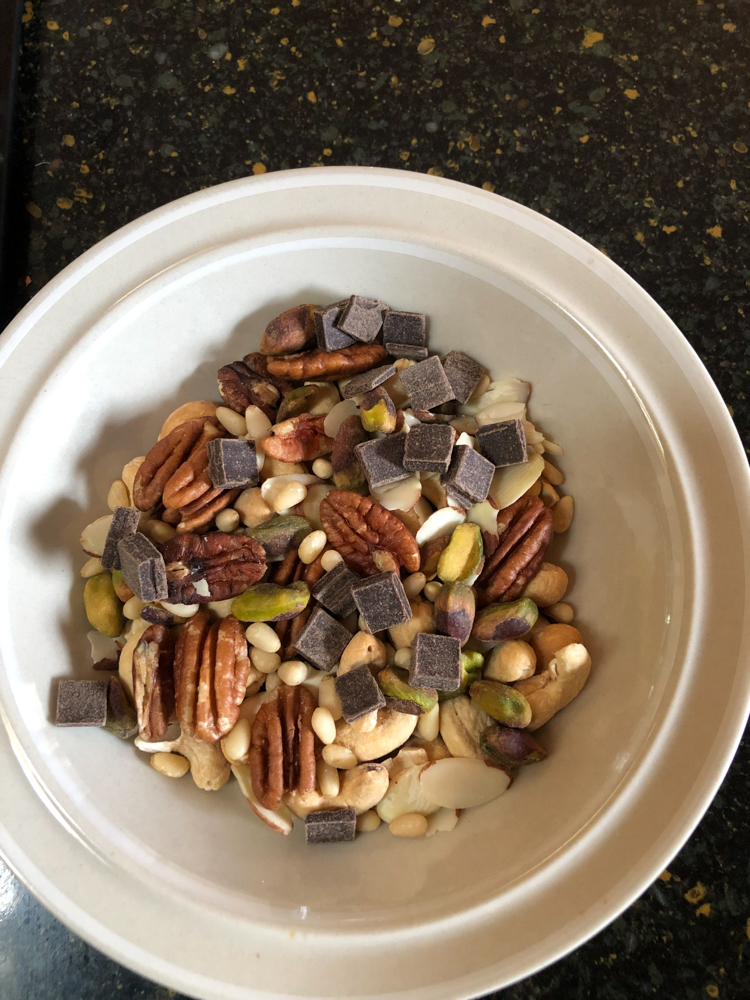
Make-Your-Own
Wait, what? Why temperature? In summer, unless you like gooey chocolate-covered fingers, it’s best to avoid anything that might melt in the heat lest you get gooey clumps.
The possibilities are endless: experiment with shredded coconut, dried chopped apricots, golden raisins, dates (if you’re sensitive to sulfur like I am, make sure they don’t have any preservatives), hazelnuts, cereal bits (if you can tolerate cereal; I cannot), walnuts, butterscotch or white chocolate chips, macadamia nuts… The list is endless.
Be sure each ingredient is something you enjoy and is on your green foods list. Avoid adding fresh fruit to your GORP as it requires eating the same day you make it. Sometimes leftover GORP from one hike becomes a starter for my next. Enjoy!
Client FAQs 2: Pack Basics
Another client asked me to list what I consider basic pack essentials for a day hike up to ten miles. Client FAQs 2 is more common than you might think, and it gets asked a lot through the Seattle Mountaineers, an organization I’ve been a member of for more than 30 years.
For a packing list for a 6.5-mile hike to Talapus and Olallie Lakes on July 31, I started with the Ten Essential Systems and customized them to my needs. You’ll notice I didn’t carry a fire starter, emergency shelter, knife, or headlamp. In over thirty years of hiking, I’ve never used or needed any of the first three, and while a headlamp is a great idea if you think you’re going to be out close to dusk or before dawn, I time 98% of my hikes to start just after sunrise.

Wearables
- Comfortable hiking boots. My current boots are Keens over-the-ankle that have a wide-toe-box
- Two pairs of socks: a lightweight liner and a mid-weight wool layer; if you anticipate lake wading, as we did in Olallie, a pair of wading shoes or flip flops and a small lightweight towel to dry off
- An extra layer of clothes depending on the season – wind jacket or raincoat, down sweater, sunproof long-sleeved shirt, tucked into the bottom
- Brimmed hat, bandana, and sunglasses to protect your face and eyes from sun glare
Consumables
- At least two liters of water or the equivalent; I carry four, so if the trail is dry my dog and I have spare
- Snacks you expect to eat plus extra in case you are out longer than you anticipated. Many people undershoot here. I always come back with extra.
- Kibble and a leash, including attached spare baggies, for my dog

Portables
- A tested, adjustable pack that sits on your hips rather than your shoulders. Depending on what you plan to carry, they vary in size. The larger the pack, the more you carry. My go-to pack is an Arc’Teryx that I can use for day hikes or a 3-day climb of Mt. Rainier.
- Trekking poles stuck in the side pouch; on this hike I never used them
- Optional: a quarter sit-pad so I don’t have to sit in the dirt; on this hike I used it
- Basic First Aid kit with 1/4 roll of toilet paper and plastic baggies, moist towelettes, aspirin/Ibuprofen, bandaids, and Moleskin; on this hike, I used a patch of Moleskin
- Phone with Merlin Birding app, Notes, and camera. I strongly recommend GPS or map and compass, and the ability and knowledge to use them in case you don’t have cell service where you’re going or your phone dies. I use all three to record anything cool I might want to share in the future
- Wallet with ID/cash in case you need something on the road
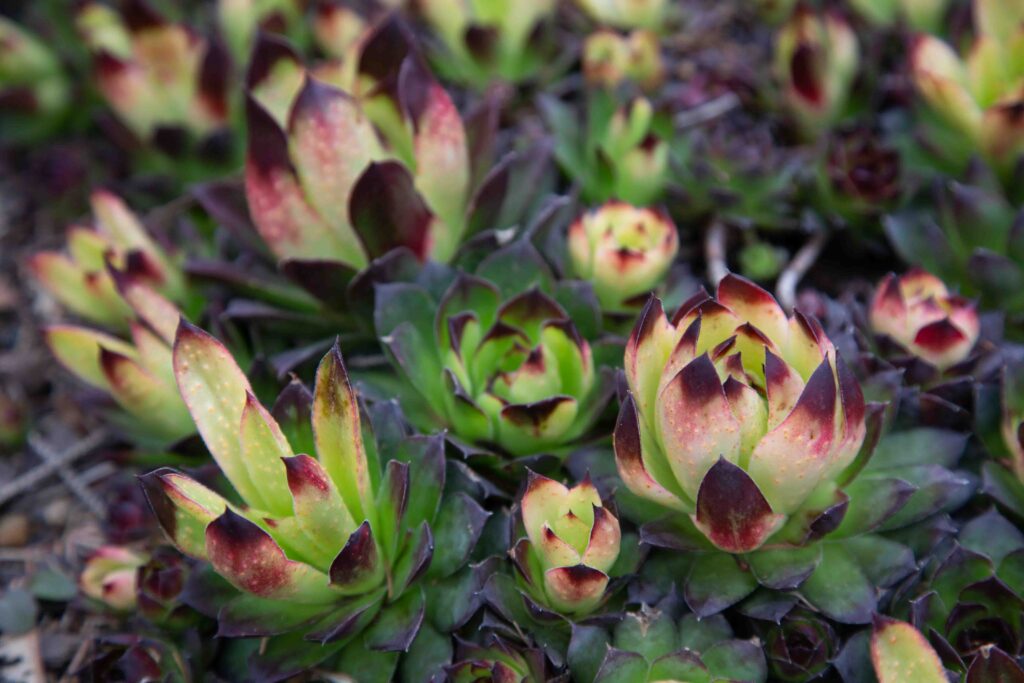
Use this list as a starting point to create your personalized list. I am of the “better to have too much than not enough” camp, but I know Mountaineers minimalists who would scoff at carrying a sit-pad, extra food, and wading shoes. I once climbed with a gentleman who believed if he returned to his car without getting tired, hungry, or cold at some point, then he carried too much.
Client FAQs 3: Squat Tricks
Client FAQs 3 applies to every woman who enjoys wilderness travel. Several female clients have asked how to get more comfortable getting into a deep squat position for, ahem, obvious reasons. Below are links to two strength moves and two stretches to get you started.
Squat Variations
- Do some wall squats to build up your isometric (holding) strength. The deeper you can go, until your thighs are parallel to the ground, the more comfortable you’ll be squatting in the woods.
- Perform bench squats. If you have a way to set adjustable heights on a step or a stair, first make sure you can get up from a 17-inch (standard chair) height without hands. No problems? Decrease the height by one to two inches until you can’t go any lower, then practice hovering just over that height until you master it. Vary your foot positions wider or narrower, to see where you’re most comfortable. Keep lowering the height as you get stronger, ideally getting your butt to your heels (full range of motion). Be sure you’re not dropping onto the chair or bench; keep your movement under control lowering and raising.
Hip Stretches
- Practice opening up your hips with a prone frog stretch to prepare for greater depth. I prefer the vertical version, shown below.
- Another great hip opener, if you’re stiff in the hips, is the seated glute stretch, demonstrated below. Hold each 30-60 seconds.

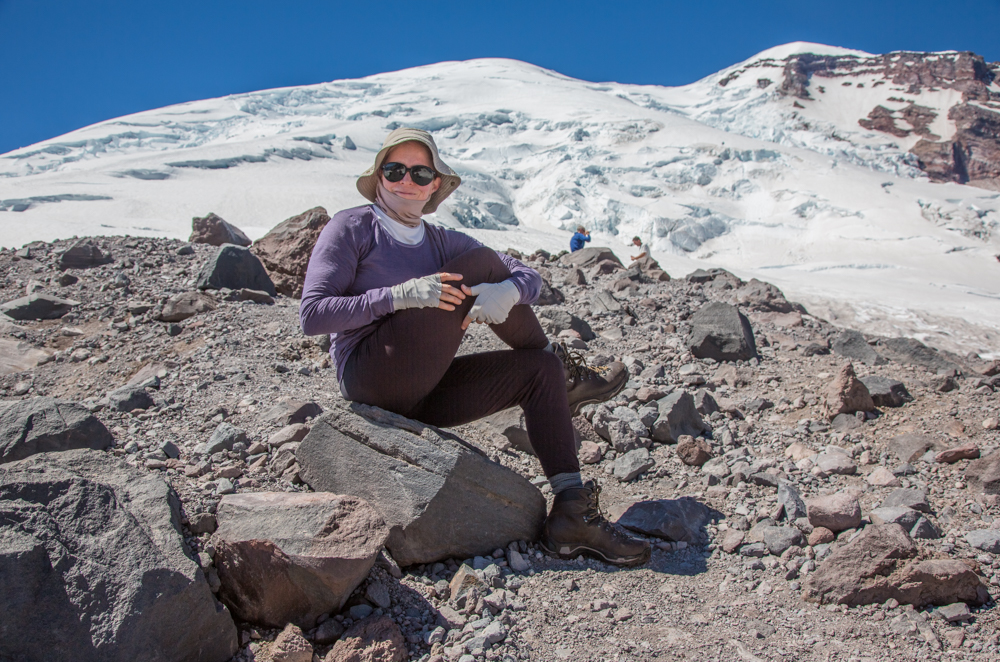
Client FAQs 4: Preserving Your Trekking Poles
Client FAQs 4 was a new-to-me question, one I thought had merit to look into more closely. A client asked whether people who use trekking poles on pavement wear them out with all the pounding on solid concrete. I got a suitable answer from here, namely, to first investigate whether you have rubber or carbide tips. Carbides are super durable on all surfaces; rubber tips will wear out eventually.
So, if you have carbide tips, you can be confident using them on anything; they can handle it. If you have rubber tips, investigate what’s beneath them, You may want to save the rubber tips for when you need them — i.e. to grip rock in the field.
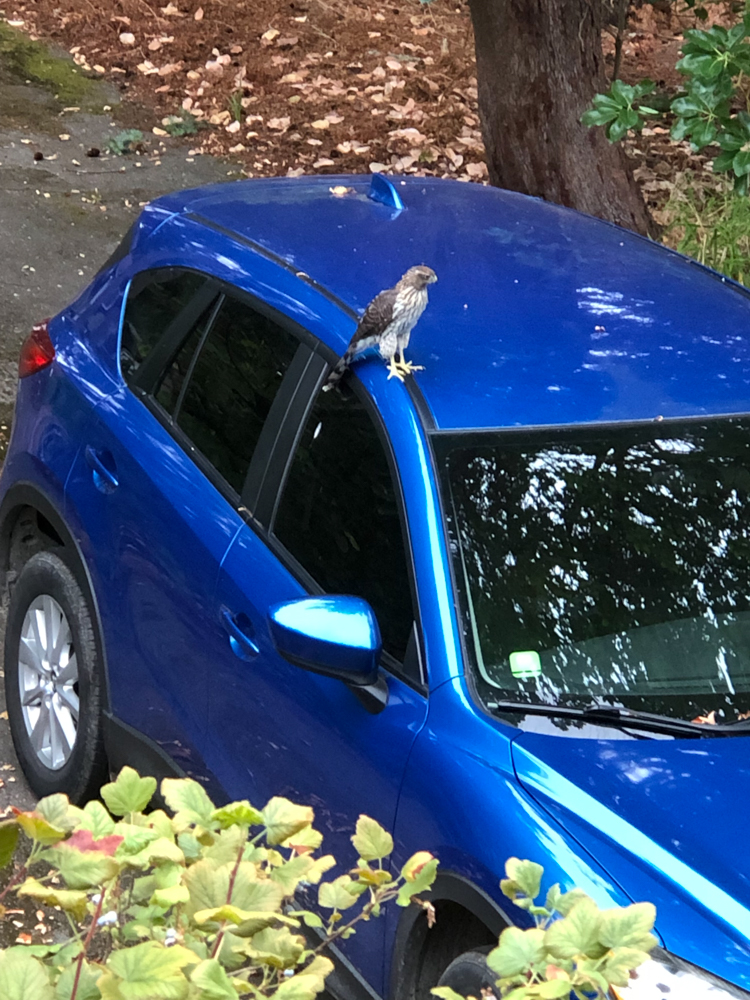
5: Tackling Compulsive Overeating
Finally, client FAQs 5 is more common than you might expect. With no single solution. The question: how to tackle a long — years to decades-long — history of compulsive overeating.
CE (sometimes called binge eating disorder) is very complicated and deserves more than a paragraph or two. But as a starting point, consider exploring one of the following steps that resonates most with you. And if you’re looking for compassionate support, I’m here to help!
- Slow down and pay attention. We often go into autopilot to tune out. Before we know it, we’ve consumed much more than we intended. Permit yourself to be mindful and aware. You can still eat — just be present while you’re doing so. Enjoy your food rather than punishing yourself for something that happened earlier.
- Learn what your unique hunger cues are. Look for the satiation sigh, your body’s sign that you have had enough.
- Eat when you’re legitimately hungry. If you’re reaching for food for any other reason, pause and ask what you really need, rather than pizza or ice cream.
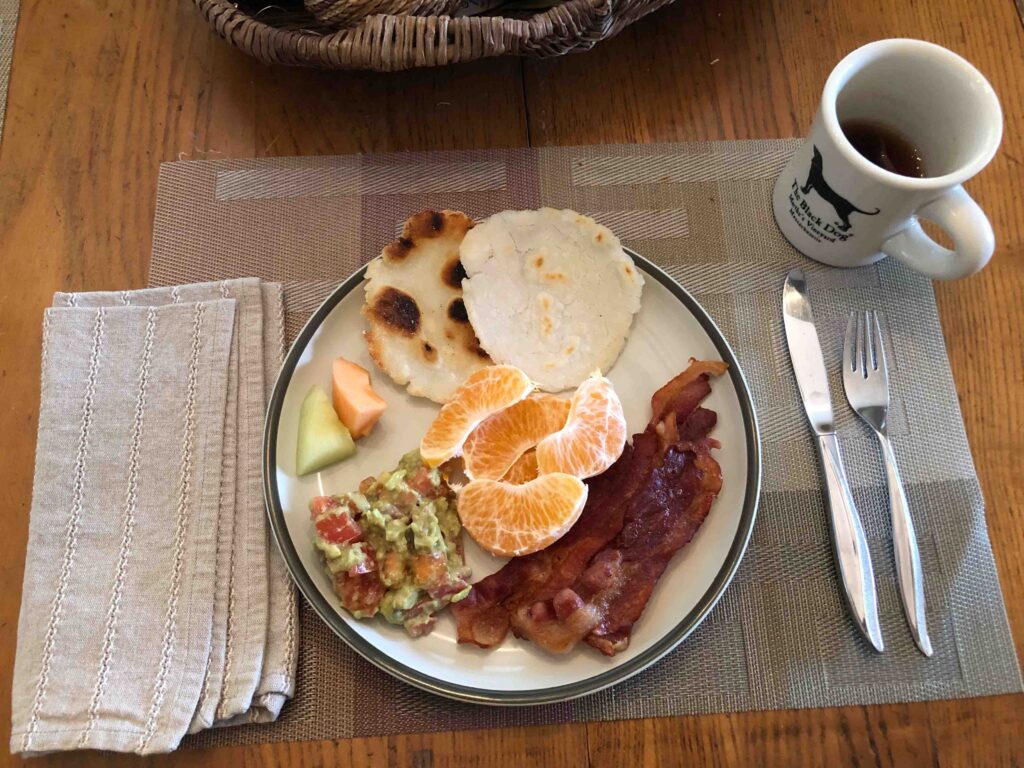
More Tips
- Eat regularly, rather than dieting. Make sure you’re getting the essential nutrients. Sometimes people keep eating because their bodies need something they’re not getting enough of in their diet.
- Stay active. Not only does this help all health measurements, but it can take your mind off your go-to: food.
- Stop BEFORE you are full. You can always have more later when you’re physically hungry. (And if you’re thinking, yeah, no, Court, an 18-wheeler couldn’t stop this train wreck, you are not alone! See tip one.)
- Finally, and perhaps the most important one, identify what triggers you. Every habit is there for a reason. You may have outgrown that reason, leaving you with a habit you wish you didn’t have. What new habit might you replace it with? And if you feel like you’ve tried everything under the sun, you may be in the frustrated, fail-constantly state of precontemplation, where you’re simply not ready to change. Yet. And that’s okay. There are still plenty of things you can try to take back your health. And I’m here to help.
- For professional medical guidance, get help from a qualified caregiver.

Client FAQs Takeaways
As C. S. Lewis said, “You are never too old to set a new goal or to dream a new dream.” In this eclectic post, I’ve highlighted five client FAQs. Each highlighted question was from a woman who was trying to make changes to improve her daily life experiences. Maybe you could identify with wanting a better energy snack (GORP) or getting stronger for hike performance (squats). If you’re a beginner wanting to get a backpack ready, you might have questions about what to pack (pack basics), or how to make sure you don’t destroy your gear while training (trekking pole tips). Perhaps you want to overcome habits that don’t serve you (such as compulsive overeating).

Where are you trying to change? I love sharing my knowledge with readers and am actively seeking ways to get more helpful tips to you. But to do so, I need your input. What would you like help with? Please feel free to suggest ideas in the comments. I’m here to help you succeed. Let’s collaborate!

Hi Court- thank you for the post. For number 5 I am usually good about packing snacks for my day so I don’t get too hungry but yesterday I ended up doing a strength training workout, going to the climbing gym and doing a run on the treadmill all without eating. When I got home I was ravenous and eating everything I could get my hands on. I haven’t done that in a long time and I was mad at myself for letting it happen. It is simple to pack some nuts or half an almond butter sandwich or whatever. It is so easy to get out of control when you are starving. Thank you for the blog and congrats on 3 years!
Thanks for the comment and for the congrats. It’s been a journey! I love your recognition of how easy it is to lose control when you are ravenous. Rather than getting angry at yourself (self-beration is so easy to get into) it might help to get curious and compassionate and use this as a learning event for the future. Very easy to pack something to have available — that’s called “shaping the environment” — including a protein shake or the snacks you mentioned. Let that prod you to different behaviors and a better understanding of how best to fuel yourself to fitness and fun! Appreciate your readership and your example!